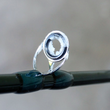The first big blue shark appears in Capt. Joe’s chum slick, sucking in chunks of menhaden. Soon it’s joined by a second, smaller blue that gets hooked. The first blue reappears and mounts the hooked fish, placing Capt. Joe, First Mate Leo, and me in the tiny group of humans who have witnessed shark copulation.
As the two animals thrash in coitus Capt. Joe and Leo gaff the unhooked male and haul him into the boat. Leo points out the sperm-injecting pelvic-fin appendages that biologists call “claspers” because Aristotle misidentified them as such. “Look,” he declares. “They got two penises, one for port and one for starboard.” Then he gaffs the hooked female. Both sharks bleed and bake in the unyielding June sun.
Back on shore, Capt. Joe and Leo dump their dead fish on the asphalt parking lot at the Bayshore [Long Island] Mako Tournament field headquarters. I wade through a reeking stew of bile, blood, offal, and stomach contents, inspecting dead sharks piled around me — shortfin makos, blues, sandbars, duskies, common threshers, great whites, smooth hammerheads.
A small, Asian man wielding a knife and bucket dashes from the shadows, slices off a sandbar fin, gets yelled at, and retreats. National Oceanic and Atmospheric Administration (NOAA) Fisheries biologists Jack Casey and Wes Pratt are necropsying the carcasses.
Later, tournament crewmen, one on each tail and head, sling carcasses into garbage trucks. “Better that we kill them than they kill us,” intones a young girl. The year is 1980. I’m on my first assignment for Audubon magazine.
Back then so little was known about sharks that necropsying had a purpose. Not so much today. But data supposedly gleaned by chopping up dead sharks is the prime excuse offered by shark-killing tournament promoters.
This from Ret Talbot, co-author of the shark-biology book Chasing Shadows: “There was a time, certainly in the early 60s and 70s, even into the 80s, when we knew very little about the biology of sharks and we were learning something about them through tagging. But even tagging them was very rudimentary. Today when we’re attaching all this instrumentation to sharks, and there’s a fair number of them showing up as bycatch anyway I think it’s much harder to make an argument that tournaments are important to science.”
“I hear this [data-from-necropsies] argument a lot,” says Bill Mckeever, founder of Safeguard the Seas. “It’s a specious argument foisted on an uneducated public. Through tags we’ve learned where sharks go, where their birthing areas are. You don’t have to kill sharks to get that information.”
Until last year there were three long-running shark-killing tournaments in Canada, all in Nova Scotia. Canada’s Department of Fisheries and Oceans canceled them on grounds that the alleged “vital data” from necropsies was worthless. “The issue we are facing today is that the scientific data gained by landing sharks from tournaments in recent history is not contributing or advancing departmental DFO shark research,” explains DFO resources manager Carl MacDonald.
The Bayshore Mako Tournament started in 1961. Like many other shark-killing tournaments it was recently canceled (2020) because of public outrage, mass exodus of sponsors, and shark-fishing regulations.
It’s impossible to nail down the number of shark tournaments. In 2018 EcoWatch reported 70 just on the East Coast. This year 19 on all coasts were registered with NOAA as required by law, but not all tournaments register.
“I don’t think today’s public has much stomach for shark-killing tournaments,” says Dr. Greg Skomal, the other co-author of Chasing Shadows and a shark biologist for the Massachusetts Division of Marine Fisheries.
![Left] A blue shark hanging at the Oak Bluffs (Martha's Vineyard, MA) Monster Shark Tournament (now defunct). [Right] A shortfin mako shark is weighed at the Oak Bluffs Monster Shark Tournament (Martha's Vineyard, MA) in 2001. This fish became the IGFA all-tackle world record at 1,221 pounds (photos: Dr. Greg Skomal). historic shark tournament photos](https://www.hatchmag.com/sites/default/files/styles/preload/public/styles/full-page/public/field/image/sharktourney3.jpg?itok=ApSnrSuK)
“One of the biggest tournaments [Oak Bluffs (Martha’s Vineyard, MA) Monster Shark Tournament] was canceled [in 2014] when animal welfare people complained about it. Makos were a big draw for tournaments, and now they’re protected.”
Speaking for the animal-welfare community, Animal Wellness Action president Wayne Pacelle adds this: “Shark-killing tournaments are a relic of an era when people had little understanding of marine ecology and the role that these apex predators play in keeping those aquatic systems humming. Not unlike what we see with ranchers and trophy hunters ruthlessly killing wolves on the land, shark tournament organizers and participants try to attach some social value to a coastal enterprise built entirely around a blend of barbarism and backward thinking.”
Sharks can’t recover from overfishing as fast as bony species. Most give birth to dog-size litters, and those that lay eggs don’t broadcast big numbers. Embryos of the sand tiger swim around in each of two uteri, attacking and consuming siblings until only two survive. Duskies don’t mature until age 20, then deliver three to 16 pups every third year. Sandbars mature at age 16, then bear eight to 12 pups every other year at most.
Tournaments target the largest sharks, which tend to be females. Targeting breeding-age females of any species is always a prescription for disaster.
But because anglers get their fish bitten off by sharks, there’s a loud call for more kill tournaments. “There are some that have recently started,” says Skomal. “And they’re getting horrible press.” Examples: the Texas Shark Rodeo resurrected by Sharkathon; the Alabama Deep Sea Fishing Rodeo switched from no-kill to kill in 2022; the Block Island Giant Shark Tournament in Rhode Island, resurrected in 2024; and the Palm Beach Shark Tournament in Florida.
The current mantra from anglers is that there are now way too many sharks — a gross overpopulation. But none of the anglers claiming we’re experiencing an overpopulation were alive the last time there was a historical abundance of sharks — likely somewhere between 100 and 200 years ago, according to Talbot. Despite modest recovery of some sharks, at least in the western Atlantic, with the possible exception of great whites there is nothing close to a natural abundance.
“Makos are far less abundant than they were 40 years ago,” says marine conservationist and avid shark angler/researcher Charlie Witek who sits on NOAA’s Highly Migratory Species Advisory Panel. “I’m not seeing the number of blue sharks I recall. Sandbars are starting to rebuild. NOAA is doing a good job under this administration. Under the previous administration, the US and the EU were the primary obstacles to mako protection at ICCAT [International Commission for the Conservation of Atlantic Tunas]. “Once the administration changed, we put harvest rules in place.”
There wasn’t even a management plan for sharks until April 1993. This regulated 39 species, dividing them into large coastals, small coastals, and pelagics. For recreational anglers, it established a trip limit of four sharks per boat for large coastals and pelagics and a daily bag limit of five per person for small coastals. It also prohibited finning and the sale by recreational fishermen of sharks or shark products. Some (not all) tournaments got around the regs by going to “no-kill, photographing and releasing all catches.”
The public applauds this because it doesn’t understand that for some sharks “no-kill” is a misnomer. Sharks are extremely vulnerable to being hooked and dragged around, and many die after release. The death rate for released great hammerheads is 93 percent (all other hammerhead species suffer similar mortality. Because of their cephalofoils (hammers) their mouths are small, so they can’t pump water through their gills as efficiently as other fish), 91 percent for Atlantic sharpnoses, 88 percent for blacktips, 15 percent for bulls, 8.5 percent for tigers, 6.8 percent for blues.
Dr. George Burgess, Director of Florida’s Program for Shark Research offers this: “If you spend two hours fighting this large animal, it’s going to wear itself out. And you need to take about 30 minutes reviving it, maybe longer. But they just cut the line and claim it’s fine. Then it dies.”
NOAA has banned retention of the following imperiled Atlantic species: whale sharks, Atlantic angels, baskings, bigeye sand tigers, bigeye sixgills, bigeye threshers, bignoses, Caribbean reefs, Caribbean sharpnoses, duskies, Galapagoses, longfin makos, shortfin makos, narrowtooths, nights, sand tigers, sevengills, sixgills, smalltails, great whites. So tournament participants (and all anglers, recreational and commercial) have to release these sharks. Again, that doesn’t mean they live.
Sharks are indeed biting off fish hooked by anglers, and it’s frustrating. No one knows this better than I, having reeled in hundreds of heads and halves of blackfin tuna, false albacore, cobia, king mackerel, cero mackerel, jack crevalle, barracuda, and the sharks’ all-time favorite — yellowtail snappers. That doesn’t mean I agree with all the anglers, and even some fisheries managers, who claim we need more shark-killing tournaments.
“It’s unfortunate that fishermen are trying to bring more of these tournaments back,” remarks Burgess. “They say shark populations are booming, but they don’t have the data to look back two hundred years. Shark numbers even a hundred years ago were well beyond what we see today.”
The idea of killing sharks to save hooked bony fish is biologically unsound – 1960’s mentality. “It won’t work,” Madison Stewart, founder of the shark conservation outfit Project Hiu told The Nation. “Sharks identify fishermen with an easy meal. They follow the sound of engines they recognize. If there is food and opportunity, there will be sharks.”
Witek calls the push for more shark-killing tournaments “inexcusably arrogant.”
One reason for all the bite-offs is probably the depletion by humans of shark prey. It’s likely that 200 years ago, when sharks and prey were at natural abundance, there were fewer bite-offs because sharks were better fed.
In 2014 public outrage converted the Alabama Deep Sea Fishing Rodeo, America’s largest shark tournament, to no-kill. But in 2022 it went back to killing. According to promoters, that decision was made after consultation from head tournament judge Dr. Sean Powers, chair of marine sciences for the University of South Alabama, and tournament judge and Mississippi State University biologist Dr. Marcus Drymon. In 2021 Drymon, who necropsies the sharks, reportedly received a $118,000 grant to research “depredations,” i.e., sharks biting off fish hooked by recreational and commercial fishermen.
Via a Freedom of Information Act request, The Nation obtained a Drymon email, sent to participants of a workshop on shark depredations, that encouraged increased shark killing. Three months later, the Alabama Deep Sea Fishing Rodeo went back to killing, citing Drymon’s advice and offering $12,000 for the biggest dead shark.

There’s at least as much public outrage now as in 2014. After Deep Sea Guardians attended the July 21-23, 2023 Alabama Deep Sea Fishing Rodeo, it filed the following report about what it called this “barbaric event”: “These sharks are highly important for the ocean ecosystems as they are on the absolute top of the food chain, yet they are also very fragile … One of the very first sharks that was brought back dead was a huge pregnant female tiger shark, almost ready to give birth. They landed her on the dock and then opened her up to find more than 25-30 fully formed babies in her belly, almost ready to be born.”
The entire rationale for shark-killing tournaments was (and, to a large extent, still is) predator control as a public safety service. A good case study of the fear and loathing of sharks — the “Jaws” mindset that has popularized and sustained these events — is Donald Trump’s June 9th rant: “By the way, a lot of shark attacks lately [untrue]… I watched some guys justifying it today: ‘Well, they [the sharks] weren’t really that angry, they bit off the young lady’s leg because of the fact that they were not hungry but they misunderstood who she was.’ These people are crazy… Sharks are last on my list — other than perhaps the losers and haters of the World!”
What ecologically literate people understood well before the 1975 movie “Jaws” was that removing apex predators — wolves to cougars to raptors to sharks — has always resulted in disastrous, unforeseen trophic cascades that ripple through food chains.
As far back as 1949 forester turned ecologist Dr. Aldo Leopold wrote: “I have watched the face of many a newly wolfless mountain, and seen the south-facing slopes wrinkle with a maze of new deer trails. I have seen every edible bush and seedling browsed, first to anaemic desuetude, and then to death. I have seen every edible tree defoliated to the height of a saddlehorn. Such a mountain looks as if someone had given God a new pruning shears, and forbidden Him all other exercise. In the end the starved bones of the hoped-for deer herd, dead of its own too-much, bleach with the bones of the dead sage, or molder under the high-lined junipers.
Such lessons abound in the marine environment. For example, a team led by Dr. Stuart Sandin of the Scripps Institution of Oceanography found that sharks maintain the health of coral reefs. A decrease in the shark population creates an increase in such shark prey as groupers. The expanding grouper population then depletes parrotfish, which clear coral of algae. So coral reefs get choked to death by algae.
And researchers have demonstrated that just by being present, tiger sharks protect seagrass beds from overgrazing by scaring off such herbivores as green turtles and dugongs.
The North American Model of Wildlife Conservation, touted by fish and wildlife managers, operates partly on these principles: Fish and wildlife are “held in trust for all citizens,” and “may only be killed for a legitimate, non-frivolous purpose.”
Shark tournaments — whether dead-on-the-dock or “no kill” (frequently dead-in-the-ocean) — fling down and dance upon that model. I cannot imagine a more frivolous purpose than competing for money to see who can hook and fight to exhaustion the biggest and most sharks.
In the age of ecological awareness, shark tournaments are grotesque anachronisms — to the ethical angling community what phlebotomy knives are to the medical profession.































Comments
Rebecca Canright replied on Permalink
Thank you for such a fantastic article here. I absolutely really appreciated reading this and learning about this, as a young person I can’t believe that these shark killing contests are still happening. I share all of your thoughts, this needs to stop. If you have any suggestions of who we can contact and encourage them to stop allowing these contests to continue, feel free to let me know. I would love to write some letters. Thanks again, much warmth and gratitude to you
Arthur Howe replied on Permalink
Ted,
Thanks for your thoughtful article, which I found very informative. There is so much misinformation and erroneous public perception about sharks as a whole. I only hope other readers will share this article with friends.
Art Howe
Lead Coordinator, Maine Shark Workgroup
Frank Yaun replied on Permalink
Excellent article, glad you shined a light on this issue.
Pages